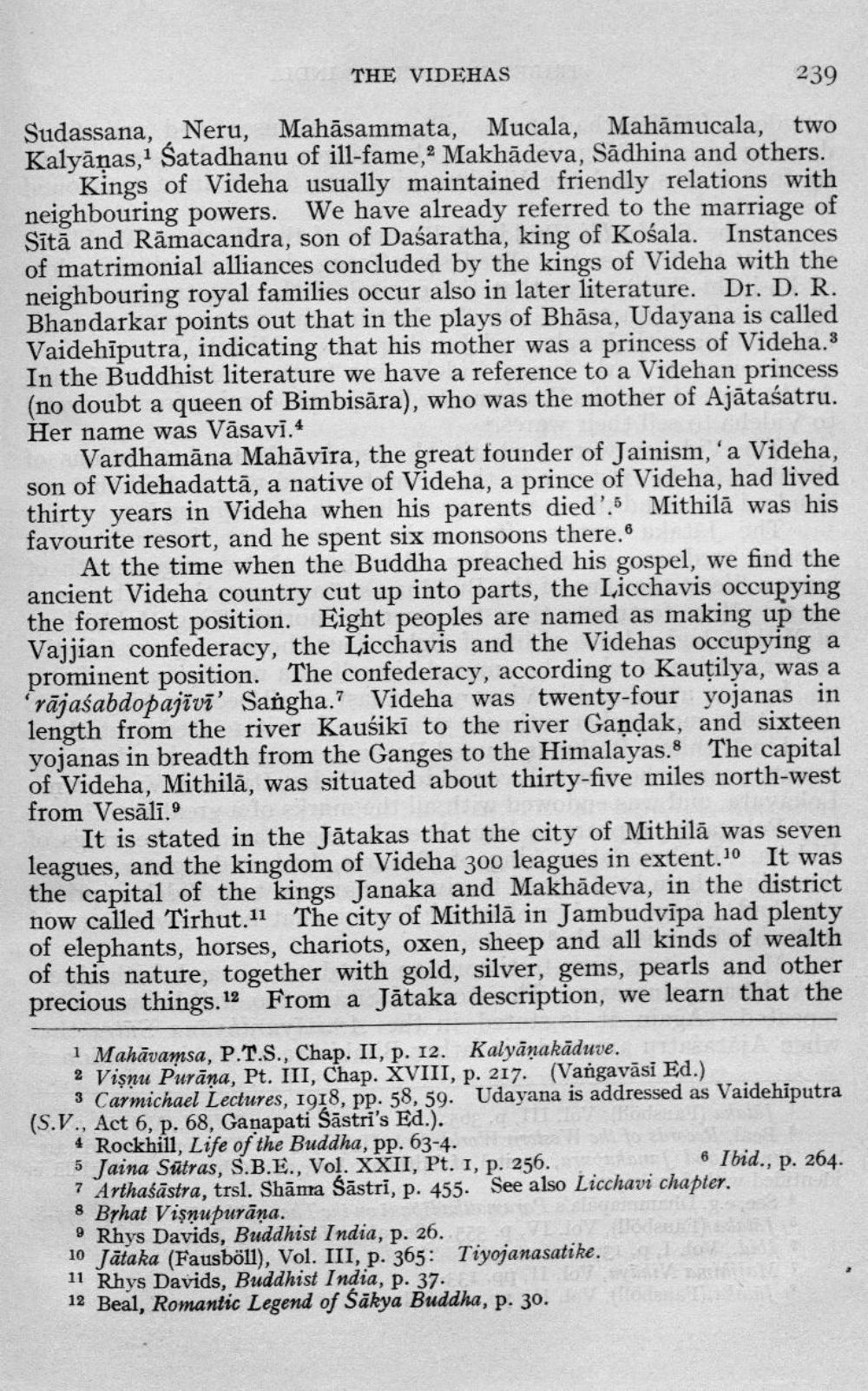________________
THE VIDEHAS
239
Sudassana, Neru, Mahāsammata, Mucala, Mahāmucala, two Kalyānas, Satadhanu of ill-fame, Makhādeva, Sādhina and others.
Kings of Videha usually maintained friendly relations with neighbouring powers. We have already referred to the marriage of Sītā and Rāmacandra, son of Daśaratha, king of Kośala. Instances of matrimonial alliances concluded by the kings of Videha with the neighbouring royal families occur also in later literature. Dr. D. R. Bhandarkar points out that in the plays of Bhāsa, Udayana is called Vaidehīputra, indicating that his mother was a princess of Videha.3 In the Buddhist literature we have a reference to a Videhan princess (no doubt a queen of Bimbisāra), who was the mother of Ajātasatru. Her name was Vāsavi.4
Vardhamāna Mahāvīra, the great founder of Jainism,'a Videha, son of Videhadattā, a native of Videha, a prince of Videha, had lived thirty years in Videha when his parents died '.5 Mithilā was his favourite resort, and he spent six monsoons there. 6
At the time when the Buddha preached his gospel, we find the ancient Videha country cut up into parts, the Licchavis occupying the foremost position. Eight peoples are named as making up the Vajjian confederacy, the Licchavis and the Videhas occupying a prominent position. The confederacy, according to Kautilya, was a 'rājaśabdopajīvī' Sangha.? Videha was twenty-four yojanas in length from the river Kausikī to the river Gandak, and sixteen yojanas in breadth from the Ganges to the Himalayas. The capital of Videha, Mithilā, was situated about thirty-five miles north-west from Vesālī.
It is stated in the Jātakas that the city of Mithilā was seven leagues, and the kingdom of Videha 300 leagues in extent.10 It was the capital of the kings Janaka and Makhādeva, in the district now called Tirhut.11 The city of Mithilā in Jambudvipa had plenty of elephants, horses, chariots, oxen, sheep and all kinds of wealth of this nature, together with gold, silver, gems, pearls and other precious things. 12 From a Jātaka description, we learn that the
1 Mahāvamsa, P.T.S., Chap. II, p. 12. Kalyāṇakāduve. 2 Vişnu Purāna, Pt. III, Chap. XVIII, p. 217. (Vangavāsi Ed.)
3 Carmichael Lectures, 1918, pp. 58, 59. Udayana is addressed as Vaidehiputra (S.V., Act 6, p. 68, Ganapati Šāstri's Ed.).
4 Rockhill, Life of the Buddha, pp. 63-4. 5 Jaina Sūtras, S.B.E., Vol. XXII, Pt. 1, p. 256.
6 Ibid., p. 264. 7 Arthaśāstra, trsl. Shāma Šāstri, p. 455. See also Licchavi chapter. 8 Brhat Vişnupurāna. 9 Rhys Davids, Buddhist India, p. 26. 10 Jataka (Fausböll), Vol. III, p. 365: Tiyojamasatile. 11 Rhys Davids, Buddhist India, p. 37. 12 Beal, Romantic Legend of Śākya Buddha, p. 30.




